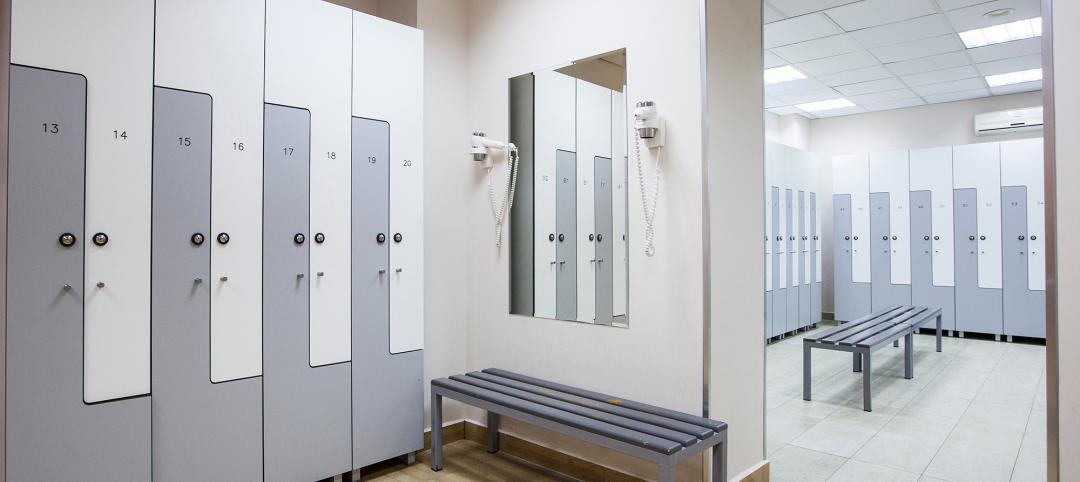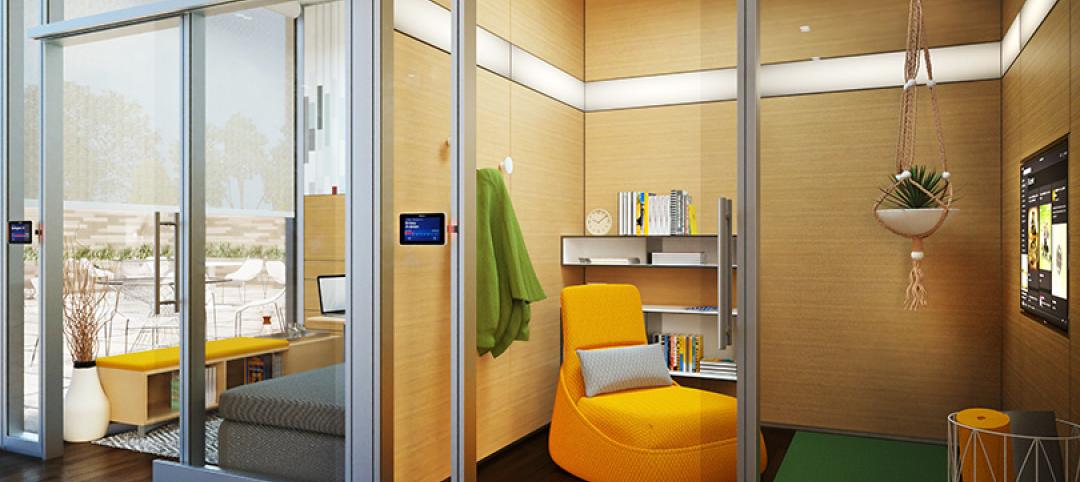For those who are involved in the design and construction community, it is likely that you have encountered the topic of mass timber construction over the last few years. And for good reason! When sourced from sustainably managed forests, the use of wood as a replacement for concrete and steel on larger scale construction projects has myriad economic and environmental benefits that have been thoroughly outlined in everything from academic journals to the pages of Newsweek.
That being said, out of the approximately 700 mass timber projects that the Wood Products Council estimates to be underway or completed in North America, most of these are for office, residential or commercial uses, with only a small number being designed and built for higher education or laboratory uses. Given the environmental benefits, and the often ambitious sustainability targets of higher education clients, why aren’t we seeing mass timber in more projects on college campuses? While there are likely a number of reasons for this, one may be the fact that there is limited information on the opportunities and synergies that can be found in the use of a mass timber structure for these specific project types. It is for this reason that we are interested in sharing our experience and provide some insight into why you might consider mass timber for Laboratory and Higher Education projects. Before we dive into the detail, though, let’s step back and think about a few questions that we should be asking ourselves as owners and designers when we embark on the design of a new structure.
Are we using wood because it’s cool or because it makes sense?
Is mass timber the right fit for this project and building type in question? What unique opportunities does it afford when being used in an academic or science setting that you might not find with other structural systems?
Is it possible to deliver a high-performance mass timber academic building on a budget?
How does the way that we build up the structure leverage the benefits of the material and reduce material cost, while still meeting the strict performance needs of the higher education programs for which we are designing? How do we achieve aggressive operational and embodied energy reduction goals through the use of hydronic systems while still exposing the beauty of a mass timber structural deck, even when program limitations such as vibration criteria and budget constraints take the option for a raised floor out of the equation?
Wood structure is a good start, but what else can we be doing to decarbonize our projects?
Are we taking advantage of synergies between the unique attributes of a mass timber structure and best practices enclosure design to unlock deeper decarbonization strategies, enabling migration to all-electric hydronic solutions and away from refrigerant-based mechanical systems with high global warming potential, without sacrificing beauty and experience in the process?
While there are a number of relevant examples that can answer each of these questions, we are going to look at them together through the lens of a recent project: Edward J. Ray Hall for Oregon State University’s Cascades Campus (Ray Hall) in Bend, Oregon. This is a relevant case study, in that it is working to both understand the unique opportunities that mass timber presents in a higher education setting and also pioneer cost-effective and low-impact strategies to achieve net zero operational energy and an overall reduction in embodied carbon. This project is intended to serve as a prototype for future academic buildings on the OSU Cascades campus, but the lessons learned in its development might also help guide anyone who is working to achieve meaningful reductions in embodied and operational carbon on a mass timber higher education project.
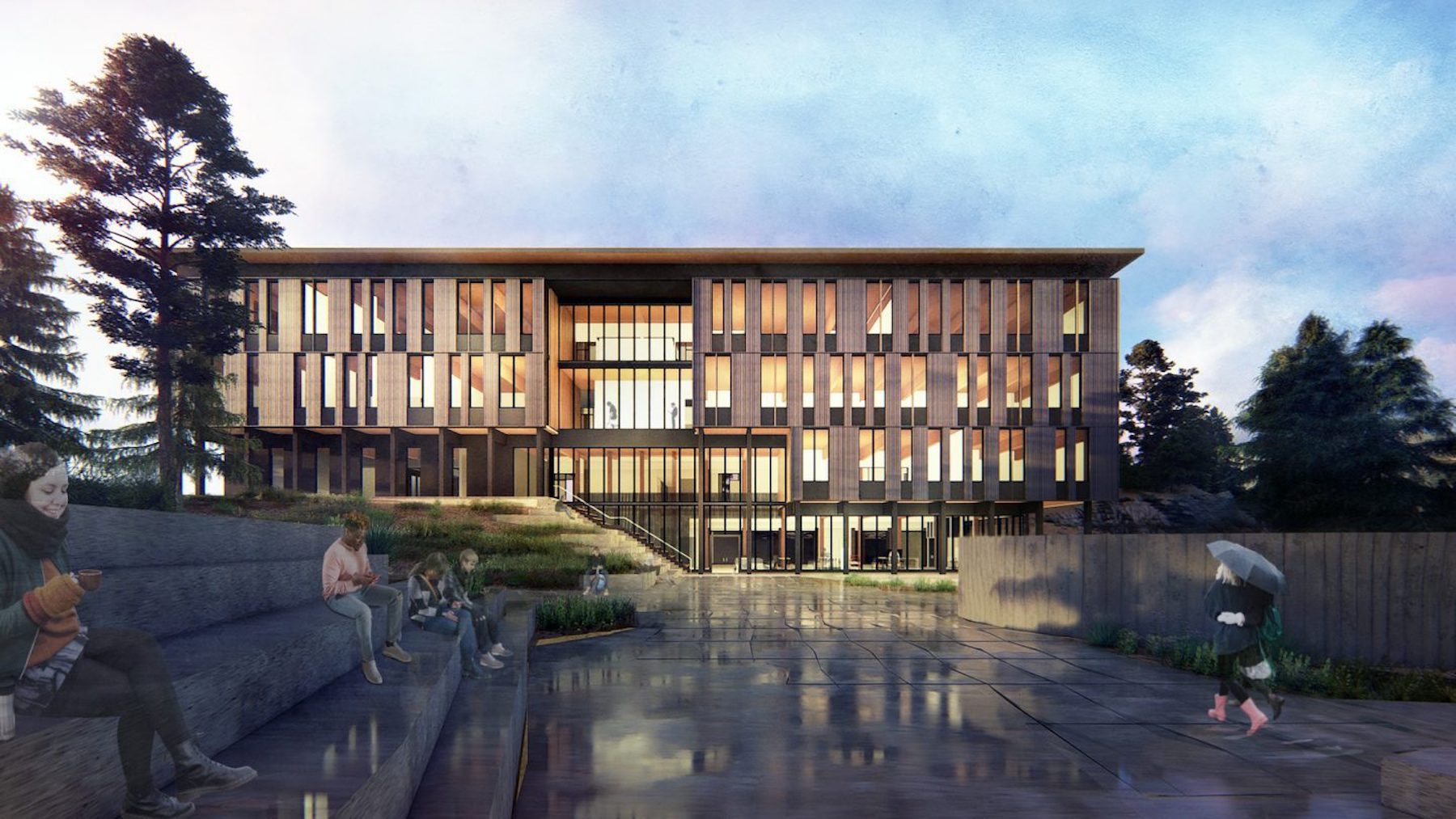
Does mass timber make sense for my Academic or Laboratory Project?
The potential benefits of mass timber are plentiful and well documented. The use of a natural material stimulates an innate and positive biophilic response in building occupants. Leveraging prefabricated components can lead to increased ease of assembly, improved precision, shortened construction schedules, and reduced on-site labor demands. Using wood provides the opportunity to support regional economies and reinvigorate rural communities in a way that can bring local industry up to speed with 21st century technologies and practices. When sourced responsibly, it may even serve to sequester carbon and help mitigate the impacts of climate change. But what are the impacts that the system has on how we design? And, more importantly, what are the unique opportunities that a Mass Timber structure can provide that can actually help improve the quality and functionality of our Laboratory and Higher Education environments?
Daylighting, Vibration Control, and Systems Integration
A good first question to ask is: what is different when looking at a mass timber structure vs. a more typical steel or concrete structure? An oft-discussed advantage of using mass timber decks such as CLT or DLT is an inherent ability to span a certain distance without the need for intermediate support. This unique characteristic has enabled designers to eliminate the perimeter beam in our structures, thus unlocking the opportunity to increase the height of our window openings. The only other type of structure that provides a similar advantage is a thick cast-in place or shallower post-tensioned concrete slab – a system that works well for larger scale projects but does not offer the same potential aesthetic, sustainability and scheduling benefits as mass timber – especially for a mid-rise academic or lab building.
So how might this opportunity to increase the height of our windows impact how we think about lab and learning spaces? In a number of studies, it has been consistently proven that good daylighting and access to views improve productivity and learning outcomes in academic environments. If one were to apply the recommended 2:1 ratio of aperture height to bay depth for optimized daylighting, higher openings lead to deeper floor plates, opening up flexibility to optimize our classroom and lab layouts without sacrificing the health and performance benefits of providing natural light to our students and researchers.
The conditions needed in order to take advantage of the improved daylighting benefits of a mass timber structure also happen to support another critical attribute of successful lab spaces: vibration control. This is tied to the fact that a fairly tight column spacing is needed in order for the mass timber deck to span independently and without the need for perimeter beams. As any structural engineer can attest, the longer a deck goes unsupported, the more deflection will occur, so more frequent columns and interior beams supporting the mass timber deck leads to improved vibration control overall. When coupled with a concrete topping slab, in which you also have the option to run utilities such as electrical and data distribution, you now have a floor assembly that can reap the benefits of mass timber structural systems without sacrificing the performance attributes required for a successful lab environment.
The final advantage of this tighter column spacing is the fact that, not only does it allow us to omit the support beam from the outside perimeter of the building, but it allows us to remove it from the interior line of structure as well. The elimination of structural supports perpendicular to the primary beams and columns accommodates clear and unobstructed overhead pathways in the deep bay pockets to run critical systems to and from primary utility runs that distribute down a central circulation and services spine. It is important to note that, in order for lab infrastructure to fully capitalize on these utility routing opportunities, an increased amount of early coordination is required between the fabricators, installers and the design team. The same is true for any wet applications, as the desire for an exposed structure above means that there is nowhere to ‘hide’ the plumbing drops that will eventually need to penetrate the mass timber deck as it makes its way down through the building.
On Ray Hall, the design team leveraged this intersection of opportunities afforded by the unique attributes of our mass timber structural system to unlock high performance and cost-effective solutions for Oregon State University Cascades. Fume hoods and their associated ducting were closely coordinated with building structure, strategically placed to utilize the clearances located between primary beams and columns and spaced in a way that wouldn’t adversely impact the daylighting and views from within the space.
The team, working closely with Catena Consulting Engineers, also studied the structural column spacing to find a solution that optimizes material use, leverages the spanning abilities of the mass timber deck, and minimizes potential vibration. Starting with a 40’-long panel module, a cost-effective fabrication length typical of most North American CLT suppliers, and considering both 3-ply and 5-ply CLT, the study narrowed the options down to either a 13’4” or a 10’0” column spacing. When coupled with a concrete topping slab, both assemblies were found to meet the required vibration criteria, but by reducing the spans of the CLT deck by a mere 40” we were able to reduce the total amount of wood in our structure by 25-30% through the reduction in CLT panel thickness from 5-ply to 3-ply. The associated decrease in overall weight of the building also led to a decrease in the amount of concrete needed for the foundations and shear walls.

Long Term Flexibility, Energy Performance, and Decarbonization
While all of these aforementioned strategies that were implemented on the Ray Hall mass timber structure are designed to accommodate lab type uses, they were also conceived with flexibility in mind so that the individual use of different academic and research spaces can adapt and change over time. This eye towards adaptability can be traced through every decision, from the overall form of the building down to the nuanced relationship between the envelope and the mechanical system, to understand how we can make mass timber academic environments realize their full potential.
When initially looking at how the building could be organized, we’ve already looked at how the team identified a bay depth that leveraged the deeper daylighting opportunities that taller openings could accommodate, but also optimized spaces around basic classroom and laboratory planning principles. What hasn’t been discussed is how, when that optimized depth is coupled with a thoughtfully constructed but cost effective enclosure, we were also able to unlock the opportunity for a more flexible, affordable, and sustainable mechanical systems option for the building that was uniquely compatible with our mass timber structural system.
When going into Ray Hall, the criteria for our mechanical systems selection was clear: we wanted an energy efficient, flexible, and cost effective strategy that would also have minimal visual impact on the mass timber structure and the CLT deck overhead, but without the use of a raised floor. In addition, we at SRG were keenly interested in following through on our own climate action commitment of reducing not only operational energy, but also the embodied carbon on our projects. Through the lens of mechanical systems, this meant finding a path forward that could minimize the use of refrigerants as a part of our thermal comfort strategy.

If you ask any architect or engineer who has worked on a commercial project with a modest budget over the last five years, they will tell you that this is easier said than done, as there is a limited set of affordable mechanical solutions that meet the increasingly stringent performance standards that are required of our buildings, let alone the embodied carbon and mass timber specific criteria that we described above. This has led to an increased dependency on the use of VRF (variable refrigerant flow) – an inherently inflexible system that has significantly higher global warming potential when compared with its hydronic counterparts. SRG worked closely with our engineers to find another path – perimeter mounted sensible fan powered boxes.
The name is a mouthful, but the technology is straightforward – low temperature hot water and high temperature chilled water is circulated through wall mounted boxes containing low mass highly conductive radiative fins that generate heat and coolth which is then circulated via efficient, compact and quiet booster fans that kick the conditioned air out into the space. It was a cost-competitive hydronic solution that not only checked all of our boxes in terms of performance and flexibility, but also moved the infrastructure for delivering thermal comfort off of the ceiling, out of the floor, and onto the perimeter wall. Additionally, due the fact that these units providing ‘sensible only cooling’, we were able to eliminate the need for condensate piping, saving labor costs and further minimizing the amount infrastructure associated with the mechanical system. With ventilation air being supplied from the corridor side and thermal comfort being addressed via the exterior wall, all that remained on our exposed CLT deck was overhead lighting and fire sprinklers on the CLT structural deck in between.
As with most highly sustainable strategies, the successful implementation of this technology not only depended on close collaboration between the owner, contractor, and design team, but it also required that there be a thoughtful architectural response in order for it to be an effective solution. For Ray Hall, that meant taking a critical look at our building enclosure and working towards a facade expression that optimized daylighting potential while still controlling peak cooling loads and limiting the amount of solar heat gain allowed into the space.
With an understanding that striking this balance would be critical to the energy and decarbonization goals of the project, from the outset SRG organized the building concept itself around the ability to ‘tune’ the facade on its most sensitive orientations. Working closely with our energy modelers at AEI, we used a parallel coordinates plot visualization tool to map the complex interactions between daylight autonomy, shading strategies, and peak cooling loads to find the optimized facade expression that would allow us to ‘check all of the boxes’ in terms of performance, experience, and beauty.
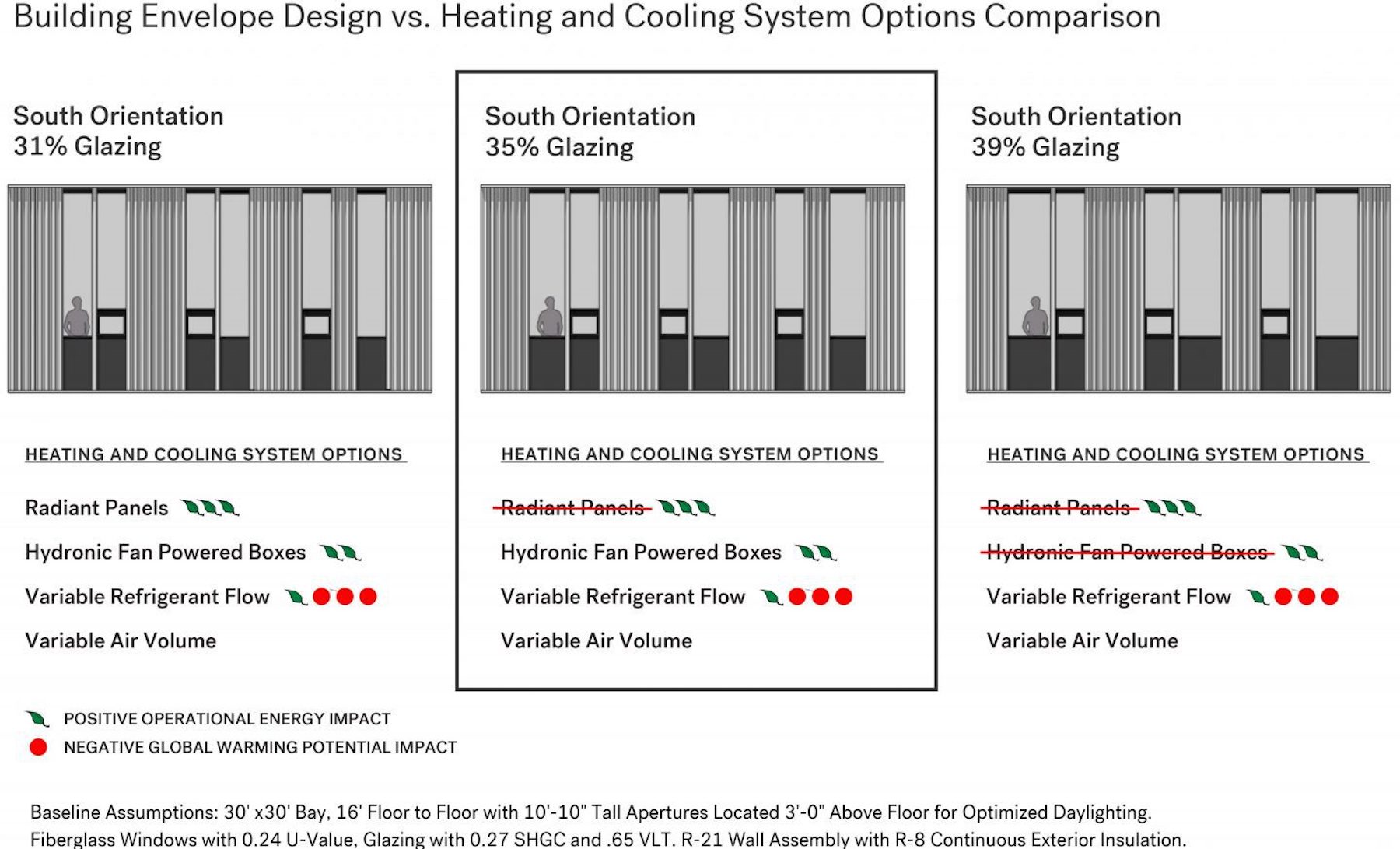

Connecting the Dots
While OSU Cascades Edward J. Ray Hall is just one example of how a deeply integrated design process can unlock the full potential of a mass timber structure on a high-performance education building, the principles and lessons learned are broadly applicable across project types. Through identifying and understanding the interrelationship between the priorities of the project and the technologies that we use to achieve them, we can find ways to get where we need to be from a program, cost, and performance perspective without losing sight of the architecture along the way. Just as teaching pedagogies and research methods evolve to respond to the changing needs and challenges of our 21st century, so does the way that we think about and build our buildings. It is at this unique convergence of established knowledge and best practices with innovations in our tools, technologies, and thinking where we can create new and different paths forward. We no longer need to choose between cost-effective design solutions that can meet and exceed the evolving needs and expectations of the owner, strengthen our regional economy, or address our climate crisis – instead we can create beautiful and lasting architecture that addresses all of the above.
This is finding the harmony between the art and science of architecture – this is what true integrated design can look like.
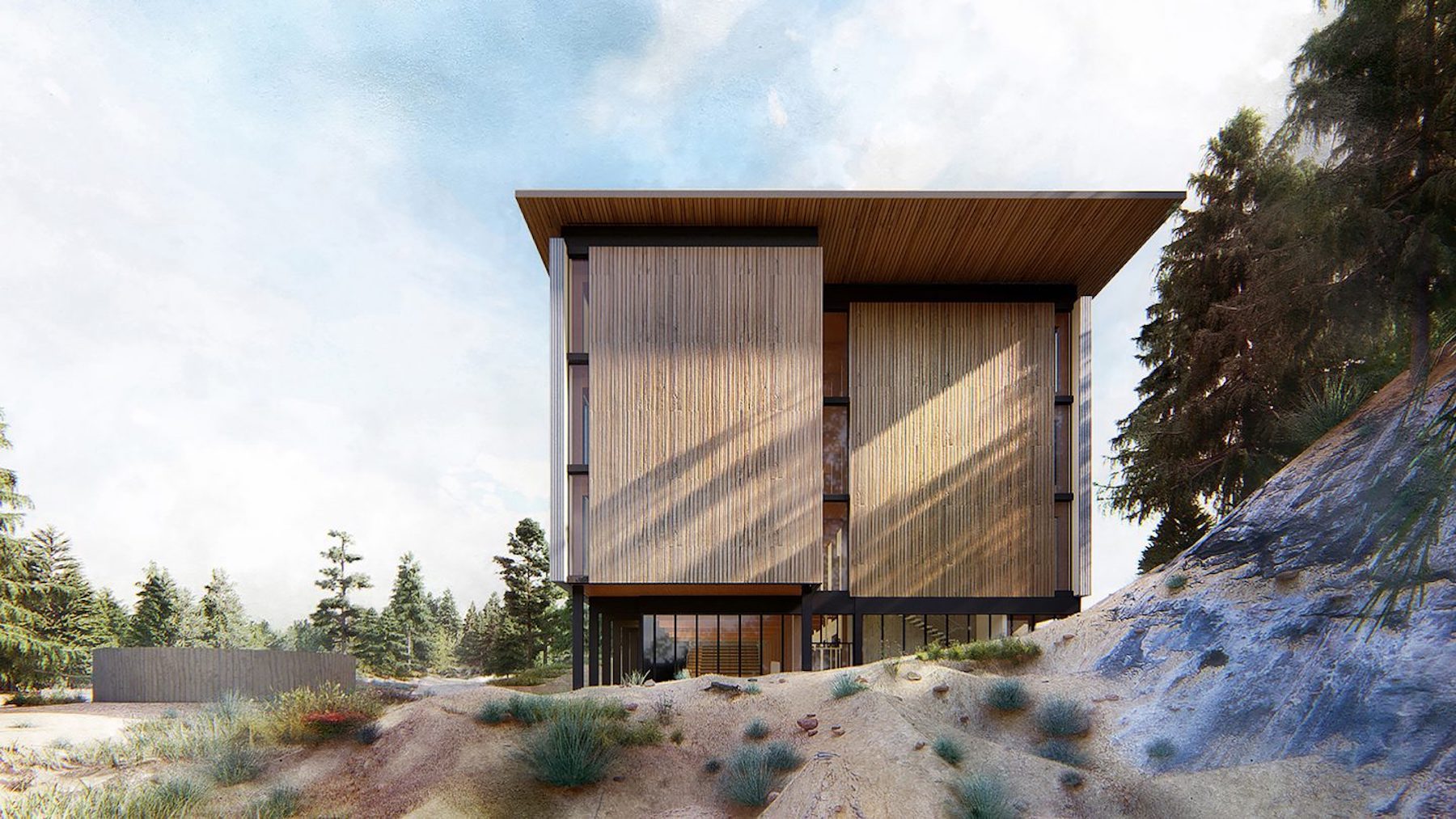
More from Author
SRG Partnership | Jul 29, 2024
Inclusive design for locker rooms: Providing equitable choice and access
SRG designers pose the question: What would it look like if everyone who wanted to use a restroom or locker room could?
SRG Partnership | Mar 6, 2023
Benefitting kids through human-centric high school design
Ingrid Krueger, AIA, LEED AP, shares why empathetic, well-designed spaces are critical in high schools.
SRG Partnership | Aug 10, 2022
Increasing the skilled workforce through career technical education
There is a shortage of skilled workers in the United States, a gap that has only gotten wider with the advent of COVID.
SRG Partnership | Jun 9, 2016
Designing for interdisciplinary communication in university buildings
Bringing people together remains the main objective when designing academic projects. SRG Design Principal Kent Duffy encourages interaction and discovery with a variety of approaches.
SRG Partnership | May 21, 2015
How CLT wood construction affects project cost
SRG Partnership's Emily Dawson shares insights on the installation, availablilty, and cost of cross-laminated timber (CLT) construction, based on the firm's recent project at the Oregon Zoo.
SRG Partnership | Apr 9, 2015
How one team solved a tricky daylighting problem with BIM/VDC tools, iterative design
SRG Partnership's Scott Mooney describes how Grasshopper, Diva, Rhino, and 3D printing were utilized to optimize a daylighting scheme at Oregon State University's new academic building.
SRG Partnership | Mar 23, 2015
Drones for AEC: How every stage of a building project can benefit from drone technology
From photo-mapping to aerial progress videos, SRG Partnership's Dmitriy Molla studies real-world applications for unmanned aerial vehicles.
SRG Partnership | Feb 9, 2015
The generalist architect vs. the specialist architect
The corporate world today quite often insists on hiring specialists, but the generalists have an intrinsic quality to adapt to new horizons or even cultural shifts in the market, writes SRG Partnership's Gary Harris.
SRG Partnership | Jan 5, 2015
Beyond training: How locker rooms are becoming more like living rooms
Despite having common elements—lockers for personal gear and high-quality sound systems—the real challenge when designing locker rooms is creating a space that reflects the attitude of the team, writes SRG Partnership's Aaron Pleskac.
SRG Partnership | Dec 18, 2014
In response to ultra-open and uber-collaborative office environments
Susan Cain’s bestselling 2012 book, "Quiet: The Power of Introverts in a World That Can’t Stop Talking" has made an impact on how we understand our current workforce, recognizing that at least one-third of the people we work with are introverts, writes SRG Partnership's Susan Gust.


